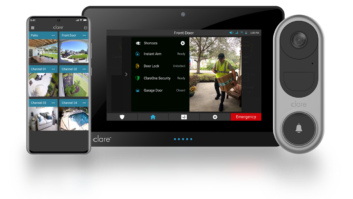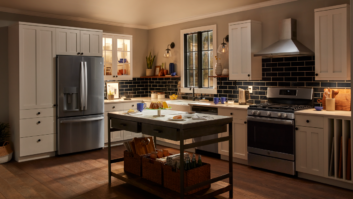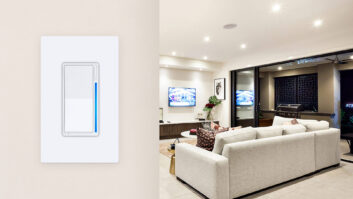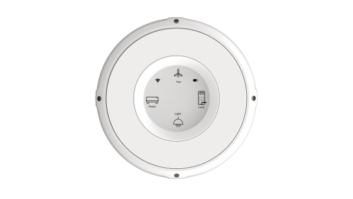Smart, automated lighting has been one of this industry’s drivers for years. As homes get larger, having a way to manage all of those lights by scenes or automation makes for better living. And with homes having an average of 67 lights (according to the Department of Energy), lighting control’s popularity is likely to continue.
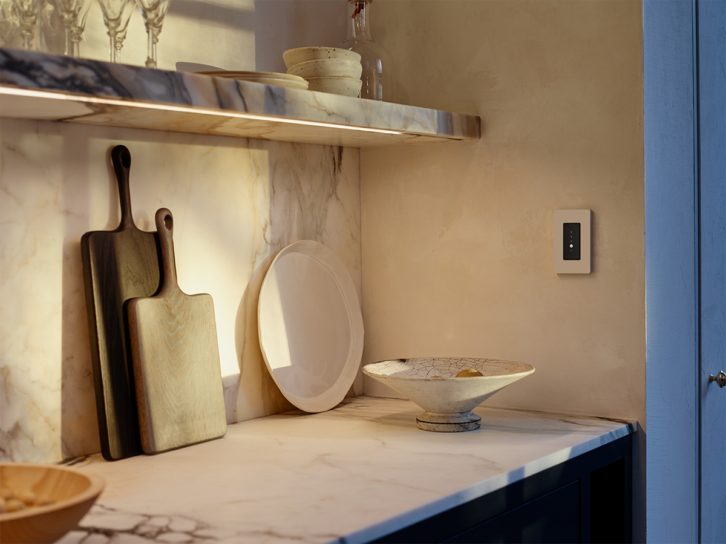
If you’re reading this, I bet that you both sell and own some kind of smart lighting control system. In my home, I am practically batting the lighting control cycle, with devices from Crestron (Pyng), Lutron (RadioRA2), and Control4 (both Wireless and Essentials). (One of the “benefits” of being a product reviewer.) This includes a variety of keypads, fan controls, dimmers, and switches. Plus, I’ve had plenty of other systems installed over the years, including URC and Savant.
But as cool as automated lighting is, the controls themselves really aren’t that cool. I’m talking about the things on the wall that people actually use to interact with lights in the home. Most of them are basically just decora paddles or buttons, maybe with an LED to indicate dimming level. I mean, sure, a backlit, laser-engraved keypad is classy, and if you add a fancy screwless plate like one of Lutron’s stainless-steel models it certainly oozes luxury and style, but is it cool?
As an industry professional, when is the last time you got excited by a light switch? Has it ever happened?
Let me introduce you to the Orro One.
Where most developments in lighting control now are evolutionary, the Orro One, with its built-in Amazon Alexa integration, full-color touchscreen control, and wide interoperability with other brands, is revolutionary. But it is Orro’s Control4 integration capability that will make it of particular interest to any C4 dealers, giving them a powerful new control option at a price that will make it compelling on every job.
As the opening statement that greets you when you open Orro’s box says, “Welcome to better lighting.”
Installation
The installation experience begins with the unboxing, and this is a case where Orro makes a fantastic first impression.
Now, I get that when we sell lighting control systems from our preferred brands — Control4, Crestron, Lutron, Savant — these are either being installed by us or by an electrician, so they don’t really need to make an impression.
I’ve opened plenty of lighting devices, and they are all ho-hum at best, typically packed into small, cramped, boring packaging whose sole purpose is to safely transport the device from point A-to-B. But opening Orro’s packaging actually made me excited about installing and using it even before I had it out of the box and was akin to the experience of unboxing an Apple device.
Inside the well-packed box is the switch itself along with a single-gang screwless wallplate, a really well-written installation guide with four-color images illustrating wiring connections for single- and multi-pole installations, color-coded extension wires and labels, and a package of wire connectors and screws.
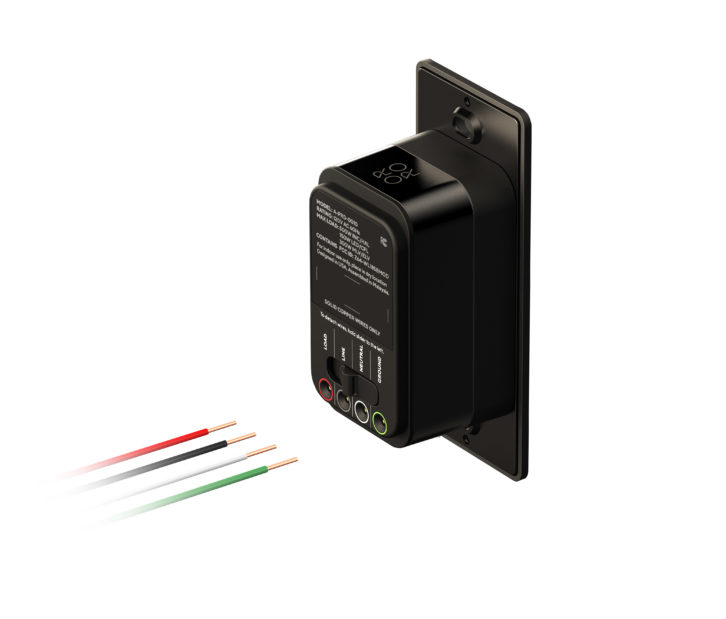
The Orro One will control all manner of common bulb types, including LED, CFL, MLV, ELV, Incandescent, and Halogen, and can control loads up to 500 watts. While most lighting controls require you to specify whether it will be a dimmer or on/off switch, the Orro One can be either. It is also important to note that the Orro One requires a neutral wire to work. Another differentiator is that Orro doesn’t require any kind of hub to function; all the brains are built into the device itself, so there is nothing else to install or integrate.
Orro sent me three Ones for this review and the single-gang, decora-style design makes it simple to replace virtually any existing controller. I’m an old pro at swapping out lighting devices in my house, so it was a pretty straight-forward process of pulling out the old and replacing with the Orros.
Two comments about the installation process. First, while I liked the toolless push-in design and slider-release Orros uses for the wiring connections, all four wires — load, line, neutral, and ground — connect straight into the back of the device. As you know, Romex wire is quite stiff, and the wiring poking straight into the back of the device can make it difficult to manage into a wallbox, especially if it is ganged with other devices.
Also Reviewed by John Sciacca: PowerShades Motorized Roller Shade Systems
Second, the Orro is really a touchscreen control at heart, and most interactions require looking at its display for information. I found myself wishing they had been installed more at eye height than at switch height. Granted, I’m 6-foot-3 and my eyes aren’t what they used to be, but having them up more at eye level would be a real ergonomic improvement, and something to consider if wiring for Orros during construction.
While all of my installs were single-pole, Orro can work with “normal” switches in 3-way applications, and it senses the slight change in voltage when someone flips the other switch, allowing Orro to know the current light levels, a process the company calls “simple multiway.” It can also work in a “hybrid” scenario where Orro can control some other smart lighting devices like Lutron Caseta, sharing its intelligent presence-detection and human-centric lighting features to set lights to the correct level based on time-of-day and current light levels in the room to other devices.
Setup
Once the devices are installed and powered on, you are instructed to press the onscreen “Start” button to begin setup, where you are guided to install the Orro app (iOS and Android) on your phone. Using the app, you join Orro to the home’s Wi-Fi network, and then begin the setup and configuration process, where you assign the switch to a room, give it a name, select the bulb type, and set minimum light levels, a process that takes just a few moments but helps to ensure proper dimming across bulb types.
The Orro app allows you to connect to and control your home from anywhere you have internet access, and has three selections at the bottom: Home, Lights, and Account.
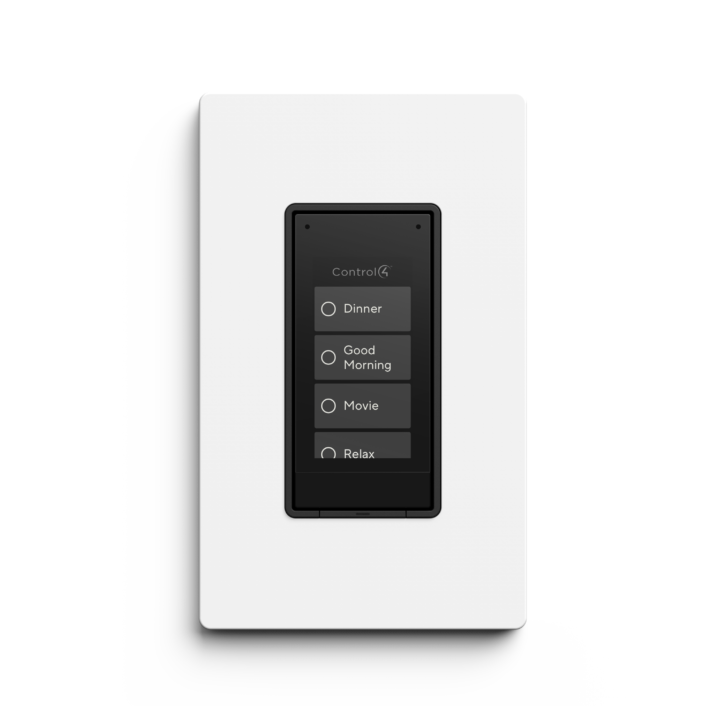
The Lights tab displays the current status of all Orro devices, giving you a quick snapshot of the home’s lighting situation. Selecting a device lets you do some configuration like creating room scenes, renaming the device, reassigning it to a different room, changing the Wi-Fi settings, or tweaking the bulb configuration.
Orro calls the touchscreen’s display screen the “Face,” and you can customize the faces displayed on each device, choosing which face appears when the switch “wakes up,” what faces are displayed, and in what order.
Each Orro also has a Presence Wizard that walks you through seven questions to determine how sensitive the device will be to detecting when someone is in the room. With some simple answers (how does the switch face the room, how big is the room, how quiet is the room, how noisy are adjacent rooms, how long do people spend time in the room, etc.) you can determine the auto-on/off settings of the Orro’s built-in motion and sound sensing. You can also manually configure and fine-tune these settings, as well as set nighttime behavior — telling it at what times to ignore movement — and turn “Auto Transition” on/off to let the switch “automatically transition between light levels throughout the day to provide the perfect amount of light.”
After you’ve completed that setup, it’s time to start adding the secondary stuff that elevates Orro from just a cool-looking lighting device to a full-blown home control station. You enable all the third-party integrations Orro can do in the Home section, and these currently include Intercom, Home Automation, Doorbell, Thermostat, Lock, Media Control, Smart Device Remote, Voice Control, and Garage Door.
As I worked through my initial setup, I felt like Steve Jobs calling out “One more thing” to my family as I kept discovering all the cool new things I could make Orro do.
“Did you know this has a built-in intercom to talk room-to-room?!”
“I’m controlling our Sonos now…with the light switch!”
“Watch this; I’m going to ask the light switch about the weather!”
Many of Orro’s current integration partners are with DIY solutions rather than products we professionally install, meaning I couldn’t fully experience all the cool things it is capable of. For example, it integrates with August, Arlo, Google Nest, and Ring smart doorbells, but not with my Control4 Chime. It integrates with Genie and Overhead Door garage door openers, but not my Liftmaster MyQ-enabled model. It works with Phillips Hue and Lutron Caseta lights, but not my Control4 and RadioRA2 lights. And it works with Ecobee, Nest, Carrier, Bryant, and some Honeywell thermostats, but not my Honeywell or Lutron.
Also Reviewed by John Sciacca: Sony HT-A7000 Dolby Atmos Surround Bar
Orro does integrate with IFTTT and SmartThings, and through that I was able to add in my Kwikset door lock, letting me lock/unlock the door and have the Orros chime every time the lock was adjusted — a great feature when you have young ones and a door leading out to a swimming pool!
While these integrations are great, the killer app for the CI channel is Orro’s Control4 integration. (They are also very close to launching integration with RTI, with plans to work with ELAN, URC, Crestron, and Savant!) With a driver developed by Chowmain, Control4 can automatically “pull in” all Orro devices to a project and then “unlock” a new array of features. For example, you can use the presence detection of each device — true or false — to fire off a series of events in that room or across the home. Even cooler, you can also create custom buttons that can be used to trigger any Control4 programming event, turning it into a full-blown system controller.
Orro has some helpful webinars and documentation on the Control4 integration, but I found it straightforward and similar to programming other devices and events.
Performance
As a lighting control, Orro performed exactly as it should; when someone walked into a room, lights turned on — or not, depending on the light levels already in the room — and after the room was empty, the lights would turn off. And as fancy as it is, control is still pretty intuitive. Press the top of the control and lights turn on no matter what face is being displayed, and pressing the bottom turns them off.
When on the light control face, you can select and drag to a precise dimming level. The devices also feature “Automatic Dimming,” remembering every manual lighting change to learn your preferences and then automatically setting for perfect lighting going forward.
It also uses an intuitive swipe left/right gesture to browse through the different faces (which, again, you can edit and sort to your preference).
I found the Sonos integration to work quite well, displaying the room, source and current track playing, along with volume +/-, pause, and skip buttons. Swipe up and you can select which room to control, group/ungroup players, and select from your Sonos favorites. In many cases this was faster to access than trying to pull out my phone and locate the Sonos app.
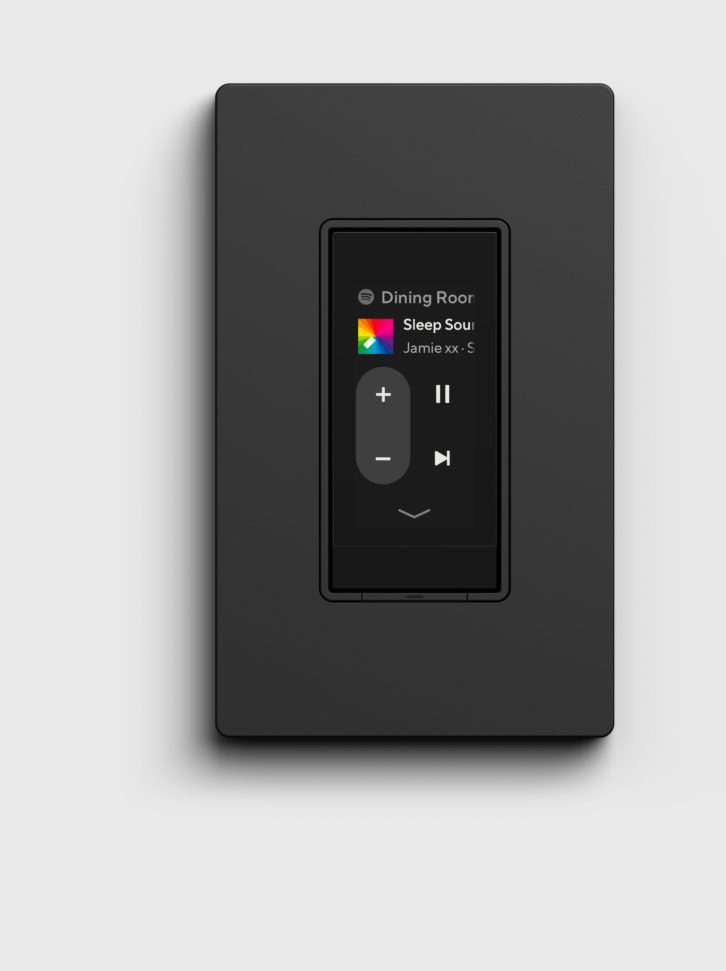
My house isn’t that big — about 2200 square feet — so we didn’t have any practical use for the intercom feature, but I can see that being a nice value-add for some projects. You can select to broadcast to a single room or to all simultaneously, and this currently uses a push-to-record, walkie-talkie-style feature that then broadcasts the message, but Orro says they are working to implement full two-way/half-duplex functionality.
While I couldn’t implement the doorbell, garage door, or HVAC features, I got a glimpse of how they work with compatible devices. The doorbell integration uses speakers in Orro devices as added chimes around the home, which is kind of cool, the garage door lets you quickly check whether the door is open or closed (and adjust it), and the climate control displays and adjusts room temps.
With Alexa built-in, you have another powerful source of voice control added to each room, and another great option for checking the weather, setting a timer, or whatever else you like to ask Alexa to do. For those averse to voice control, you can either [A] not enable it or [B] turn off the Alexa microphone. I found the far-field microphones sensitive enough that I could yell out something and be comfortable that one of the devices around the house would hear me.
Out of the box, I found the internal speaker’s volume to be pretty low, almost to the point where the speaker is useless with any background noise. I just thought this was the volume level, as there is no setting to adjust it in the Orro app; however, I discovered you can raise the volume via Alexa, and saying, “Alexa, set volume to maximum” raises the volume to 10, making it much easier to hear.
There is also an Away mode feature that can automatically turn off the lights and then use the motion and microphone sensors to detect any activity within your home, and if it senses anything it will send you a notification. You can also manually check the home’s activity and see when presence and vacancy was detected throughout the day in each room.
The Control4 integration is really where it’s at, and I added a slew of custom buttons, which can be added to all Orros or just to specific devices in the project. For example, I added a “Dinner Time” button to my dining room Orro that adjusted lights all over our house and started a Pandora dinner station in the dining room, and my bedroom has a Music On and Next buttons that start music and cycle between a variety of genres every time its pressed, with volume +/- on each pad linked to that room. Essentially, if you can execute it within Control4 programming, you can add a button on your Orro to do it.
Currently Orro’s IP communication with Control4 is a one-way street, and you don’t get any feedback from Control4. This means no status or levels of Control4 lights, shade, volume, now playing, or temperature, but Orro tells me they plan to implement those features in the future. In reality, when I press “Music On” my “feedback” is that the music comes on, and if the volume isn’t right a press of up or down gets me right. Also, the buttons are arranged on the Orro as you add them, and layout can’t be reordered after they’re added, so plan/add accordingly.
Also by John Sciacca: Perspective – Dollars Versus Percent
I did experience a few quirks with my Orros. On a couple of occasions when I went to a switch it just suddenly restarted itself. Fortunately, the lights can still be turned on/off while it is restarting, but none of the other features are available. I also had instances where the Control4 commands wouldn’t load, usually following a controller or network reboot. Sometimes rebooting the Orro by pulling out the airgap switch would fix this issue, other times I’d need to go into Composer and unlink and relink the driver. To be fair, I was in on the early beta of the Control4 integration, and this has become far more stable.
While Orro primarily works with DIY gear right now, they are working on loads of partnerships that will make it even more appealing to our channel, and they have many requested features in their engineering pipeline. According to Patrick Gall, Orro’s head of channel development, “Our strategy is to be open and to work with everyone that matters, with our ultimate goal to be ‘a flexible puzzle piece’ where Orro can add value to virtually every job, no matter the size or brands being used.” Considering that an Orro touchscreen controller is just slightly more expensive than a keypad dimmer — and is infinitely more powerful and cool-looking — it makes for an incredibly compelling alternative.
Kudos: A revolutionary development in what a lighting control can be; terrific integration with a host of third-party companies; Control4 integration is the killer-app
Concerns: Would love the screen mounted higher than switch-height; occasional restarts/integration hiccups
Product Specs:
- Touch-enabled TFT-panel display
- Human-centric and wellness-oriented smart lighting, and home monitoring capabilities
- Works with: Google Nest, Sonos, Ring, Alexa, Smart Things, Honeywell Home, Philips Hue, Bryant, August, Yale, Arlo, Ecobee, Emtek, Control4, and more
- Two built-in far-field microphones for presence detection, intercom, and Amazon Alexa integration; also works with Google Assistant
- Free iOS and Android Apps
- Works with LED, Incandescent, Halogen, CFL, MLV, ELV, and Philips Hue Smart Bulbs
- Neutral and ground wire required
John Sciacca is a principal with Custom Theater and Audio, in Myrtle Beach, South Carolina. In his free time, he blogs prolifically about the CE industry and is publisher for cineluxe.com.


